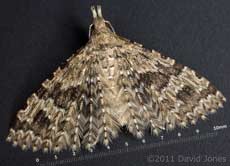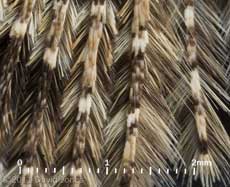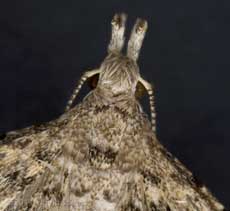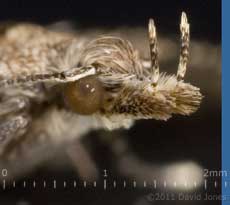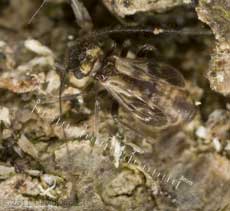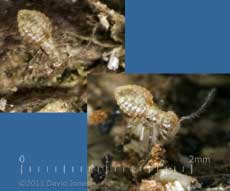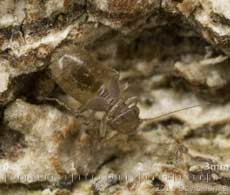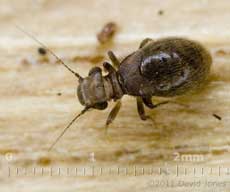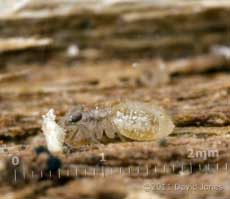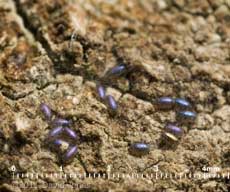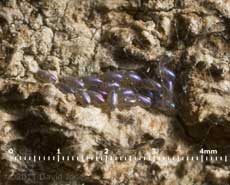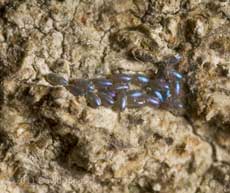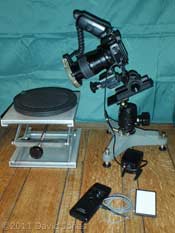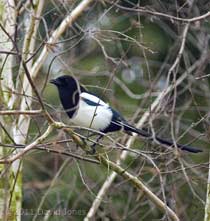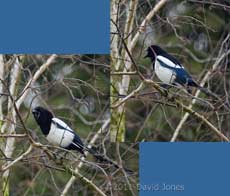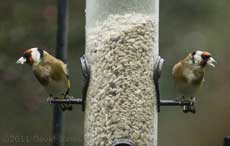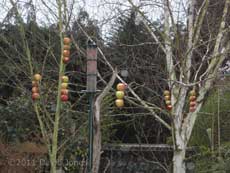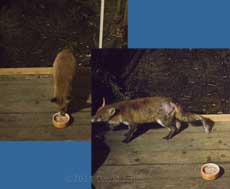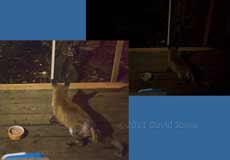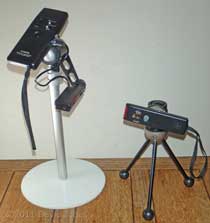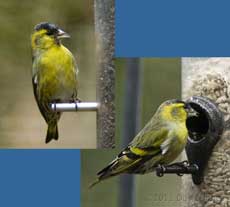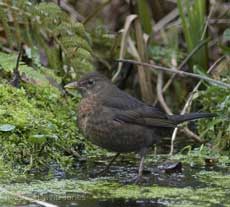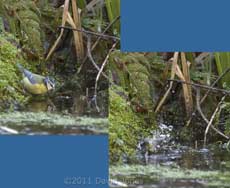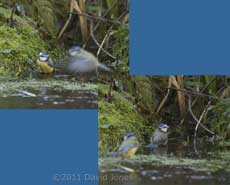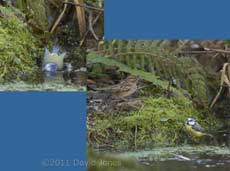Go to the last entry on this page .....Go to previous entry1 January - Best wishes for a happy, healthy & prosperous New Year. In an effort to have the new 'volume' of the diary up and ready before the chimes of midnight bring in the New Year I'm jumping the gun somewhat with this entry. Amongst the main casualties of my neglect of the diary last year has been the absence of the holiday diary for June which included the closest views I've ever had the chance to get of a Common Buzzard. Well, it is now in place and can be visited by clicking on the 2010 Diary button at the side of the screen. The menu that appears highlights both June and September holidays. Hopefully, in my efforts to sort out the 2010 mess I have corrected most mistakes, broken links etc. However, if you should come across any error that I have missed I would be very grateful if you could let me know what and where it is.
And to the day itself - A dull, dreary start to the new year with a
little bit of rain in the later afternoon. The temperature hovered around 6C
for much of the day but has dropped a little this evening. There was nothing
new to report from
the garden (no sign of the Siskin today), but the bathroom provided an insect visitor to record.
However, they are occasionally seen on mild days during the winter. This one obviously responded to the mild spell that we have just experienced.
As its name indicates its wings are divided into slender plumes (6 for each wing), and this second photograph gives an idea as to how delicate these are. Notice the flat scales that cover the supports (veins?) in each plume.
Some detail around the thorax and head - I can't help thinking that its 'hair styling' needs some attention!
Looking down from above doesn't really reveal this pair of 'horns that the moth has in addition to its antennae, which are folded back under the body.
It's a moth that is associated with Honeysuckle where its larvae feed on the buds and flowers. We have a largely forgotten Honeysuckle at the bottom of the garden. I must look more carefully at it during the summer.
2 January - A bit of very welcome sunshine today, even if the temperature was a degree or so lower (4C at 4pm). It seems as though the Siskins have moved on for now, but at just after 4pm I spotted Long-tailed Tits in the garden again - too near dusk for a photograph I'm afraid. Earlier in the day I went down to the Great Tit bird box where I was storing a large container of sunflower kernels, and in doing disturbed our sometimes resident fox that shelters in the timber store next to the box. Not having taken any 'serious' macro photographs for some time, yesterday's session with the plume moth was a very welcome wake-up call, and today I've been trying out a hopefully improved arrangement that I can set up quickly on a table top. Eventually I'll write something about it in the technical part of the diary. In order to test out what I set up I turned to my old friends the barkflies. I the log store at the bottom of the garden I have a small group of logs set aside because of the presence of barkflies on them. While temperatures dropped so low that adjacent, slightly damp logs froze together, lifting one of the 'reserve' logs inevitably revealed a barkfly that was still mobile.
Like this example, most of the adults that I see are brachypterous (reduced wings). While they seem to spend a lot of time motionless they are not in a dormant state as they will move quickly away as soon as they are disturbed.
Not only are there active adults on the log, but also nymphs, some very small, like this one (at around 0.9mm) that proved quite a challenge to photograph as it was in almost constant motion, except for brief pauses when it appeared to be nibbling at something on the log. I wonder what mechanism allows tiny creatures like this to get through periods when the temperature drops to -7C, as it did here.
Looking back through the diaries it seems that I may have misidentified this species when I first came across it - I need to correct those entries. In addition to the adults and nymphs that are over-wintering on logs, there are also eggs. On one piece of oak measuring about 12cm diameter by 27cm there must be several hundred eggs. I have yet to count them all, but in one small section there are nine clusters of between eight and twenty two eggs. 14-15 eggs seems to be about the average number per cluster. At the moment I see no sign of either nymphs or adults on this log, and it has been put away from the other logs. I'll be keeping an eye on it as we head into the year, hoping to record the time when hatching begins, and hopefully to get photographs of it happening, something I missed last year. At the front of the house we have a long establish Fuscia plant. When I swept up fallen flower heads from under it in the Autumn I put them into a small, open metal container to keep rather adding them to the composter. I've just checked the container and confirmed that there are adult barkflies of at least one other species sheltering in the for the winter. A family visit means that I probably won't get a chance to look more closely tomorrow, but I will be taking pictures as soon as I can. At 9.20pm I see that the temperature in the garden has now dropped to 2C, even with cloud cover in place. The forecast is for it to dip below freezing overnight and stay at around zero tomorrow.
4 January - After a promising start with some sunshine peeping through gaps in the clouds, overcast conditions soon returned and when I went outside to chop some wood it decided to rain! The temperature remained around 4C for much of the day.
This afternoon I have photographed some examples of Lepinotus patruelis. These can range in size from 1.3 to 2.5mm. This individual is 1.7mm in length. I find this species on very dry, well seasoned logs, mainly oak stored on my veranda. L. patruelis is regarded as a mainly domestic species and is one of three similar species that have been spread through international commerce.
This second example is, I believe, of the same species but is much darker and its abdomen is slightly more rounded (having fed recently?). As I tried to photograph this one it didn't stop running around on the cut surface of the log. The difficult of photographing it has lead me to thinking about setting up a foot switch to operate the camera shutter so that both hands can be left free to do all the necessary manoeuvring! In both photographs, you can see their very small (brachypterous) and hairy wings.
One feature that helps distinguish L. patruelis from the two similar species is the presence of a dark stripe between the eye and antennal socket.
Today I didn't succeed in recording this for the two individuals above, but you may be able to just make this out on a the only juvenile I could see on the same log. I must try to get a better picture of the feature.
I've also taken pictures to show a couple of the egg clusters I mentioned in the previous entry. As in this example, most are out in the open on the bark surface. This shows an 'average' cluster of fifteen eggs, somewhat spread out and covered with a mesh of fine silk, and exhibiting their usual iridescent blue/purple colouring.
This larger cluster of at least 22 eggs is an exception in that the eggs are crowed together in a hollow in the bark.
And this second image, taken with the light source in a different position shows how the colour can appear to change. The picture doesn't show a dramatic change, but sometimes when I use an LED torch to search for them, the eggs show up as bright blue spots. With their bright reflective nature it makes me wonder why they are laid in such an exposed way when there are plenty of crevices where they would be hidden.
One of my hopes for 2011 is to capture the moment of hatching of eggs like these - even more exciting would be the moment of egg-laying.
5 January - More sunshine today, but we were out for most of the day so I haven't any wildlife pictures for this entry. However, I have added some notes to the technical pages about the macro set-up that I've been using over the last few days. You'll see that it now includes the foot switch that I said I needed, although I have yet to put that to use. You can get to the notes through the Technical button at the left of the screen and then selecting 'The Canon 20D and 5D digital cameras'. Alternatively you can click here, although you will then need to return to this page via the Home page (or use the back function on your browser).
14 January - Since that last entry there has been very little to report on. Over the last nine days we have a short-lived frost on just a couple of mornings, mainly overcast skies (especially glum for most of today) with some heavy rain and drizzle so that everything outside has remained either damp or downright wet over the last week with temperatures of over 12C on a couple of days (and a couple of nights when it didn't drop below 5C). Activity in the garden remains at a low level. As usual it is the sparrows that provide most of the noise, and today there seemed to be more than usual in the Hawthorn, although I didn't get a chance to attempt a count, beyond being certain that there must have been at least thirty present in the early afternoon. Even that crowd found itself outdone when a group of eight Magpies turned up at the bottom of the garden, perching in our Birch and our neighbour's apple trees, and making a terrible din. They remained spread out amongst the branches of the trees so with only my long lens at hand I could only attempt to photograph one at a time, although their constant movement meant even that was problematic.
They may have a terrible reputation, but Magpies have a striking appearance, especially when light (!) shows up the iridescent blue of their plumage. As I have mentioned before, it is a pity that their call does little to complement their appearance.
The Great and Blue Tits also come regularly to the feeders, and the Collared Doves and Wood Pigeons continue their useful clearing of spilt food.
Although there is usually a Robin to be seen and heard at the bottom of the garden it is only coming to the feeding area infrequently, and I have seen a Dunnock just twice in the last week. I disturbed 'our' fox again at the beginning of the week. I happened to be taking some kitchen scraps down to out composter when the fox trotted out from between my workshop shed and the caravan. I got just a brief look at what appears to be quite an old fox. I must get on and set up a camera trap on the veranda soon. I see that the visitor counter has reset itself once again, so it has now disappeared until I can come up with a replacement!
15 January - Just a short entry on what has been another grey day, but one which has been very windy, with strong gusts that made themselves felt when I drove along some open stretches of road this afternoon. We spotted a group of bird watchers by a spot where there are shrubs heavily laden with red berries - it seems that the Waxwings are in this part of the country. When we passed by the spot the branches were empty of birds but a few moments later a flock passed over us. Needless to say, we had neither camera nor binoculars in the car. Anyway, once we returned home a check on the internet revealed that there have been Waxwings about in the general area for over a month, including the car parks of the local supermarkets. Back before Christmas I suspended apples from the Rowan and Birch trees in the hope of attracting Waxwings and/or other winter birds. These have since been eaten by the local Blue Tits and the remnants needed replacing, so at the end of the afternoon I put up a fresh supply of apples - I may add a few more tomorrow. With dusk already on us I also filled up the feeders and the fat ball holder in the Hawthorn. No sooner did I back away from that when two Long-tailed Tits arrived and went straight to the fat balls with me still just about five feet away! While it was already too dim to really enjoy their colours, I stayed still to watch them as they fed. It was interesting that they ignored me while a Great Tit that also turned up clearly decided that I was a threat and headed off down the garden until I was back in the house.
16 January - A promising bright start to the day descended back into a dull grey afternoon with drizzle and then heavier rain after dark.
I didn't get to add more apples, but this is the situation following what I did yesterday.
Last night I finally got around to setting up the camera trap on my veranda, and it worked. A fox visited the veranda twice during the night. These first pictures, recorded at around 3.50am, show a fox suffering from mange and with its tail in a rather sorry state.
The same fox returned at 4.40am. This pair of images shows a very dark, original image from the camera, followed by a processed version.
For last night's exercise I chose not to use flash (and risk alarming the fox) and rely instead on a very low wattage lamp set high in the corner of the veranda. Even with the large, f/1.4 aperture available on the lens I used, that low level of light really required a shutter speed of 1/10sec or slower at a camera sensitivity of ISO 1600. However, that was just too slow so I settled on a shutter speed of 1/20sec, producing that very dark image. Still not fast enough to freeze motion, it nevertheless provided enough detail to confirm that both visits were by the same fox. The next time I set up the trap I'll use a slightly brighter light.
The older, LC-2 controller (the two smaller units you can see in this picture) has only a limited range but has the unique facility (as far as Canon controllers are concerned) that allows you to set it up as an infrared beam. Crossing that beam triggers the camera shutter. Its successor (the LC-3) doesn't have this facility, but its transmitter does have a socket into which you can plug the output from the LC-2 receiver. The two units shown above were positioned at opposite side of the veranda, covered with clear polythene bags, the camera was set up indoors with the LC-3 receiver connected, and with all the component units switched on and the set-up tested, I headed for bed. A slightly more detailed version of this description can be found on the technical section of the website - click here.
31 January - The end of one of the quietest starts to a year for a few years. It has been a month without snow, apart from a few grains that one of my sons spotted falling a few days ago, not much rain, and temperatures that have stayed mostly above freezing. Since the mild conditions in the middle of the month, temperatures have returned to below 10C, and the last few days have been just cold enough to encourage the ponds and bird bath to develop a very thin covering of ice. Yesterday we had some very welcome sunshine and I took advantage of it to spend some time out in the garden giving our Burberis bush a long overdue prune. This afternoon was also sunny after a dull, grey start, and I did a bit more pruning, this time attacking the Buddleia next to the veranda. I haven't attempted to take any more photographs of the fox, but one morning last week I did spot it briefly on the roof of one of our sheds before it disappeared again. As well as January being a quiet month weather-wise it has also been one of very little bird activity. This morning a single male Siskin reappeared for a short time around 10am after an absence of a couple of weeks. There have been no other winter visitors, and the apples remain almost intact, apart from the attention of a Blue Tit.
While I regard the Blackbirds that I see here as probably local residents rather than winter visitors, they continue to stay away from the feeding area under the Hawthorn. However, this morning I did get the chance to record the presence of this female as she ventured onto the ice of the big pond in search of food. Notice her wide gait as she cope with the slippery conditions. And this afternoon a male made a fleeting visit to below the feeders - no chance of a photograph this time as it left as soon as it saw me move.
Later in the afternoon the male Blackbird returned, this time going to the side of the pond where I hoped that it would venture out onto the ice, but it remained all but hidden from view as it foraged.
However, as I waited a couple of Blue Tits turned up. While one perched on the log (in the middle of the pond) its companion headed down to a sheltered spot where the water has remained ice-free, and quickly disappeared in a flurry of water droplets.
The other bird was soon on the ice, but just when I thought it too was going to bathe it was disturbed by the arrival of a House Sparrow.
The first Blue Tit managed to splash water over itself just one more time before it too was chased off by the Sparrow.
Click on images to see larger version
|
|
